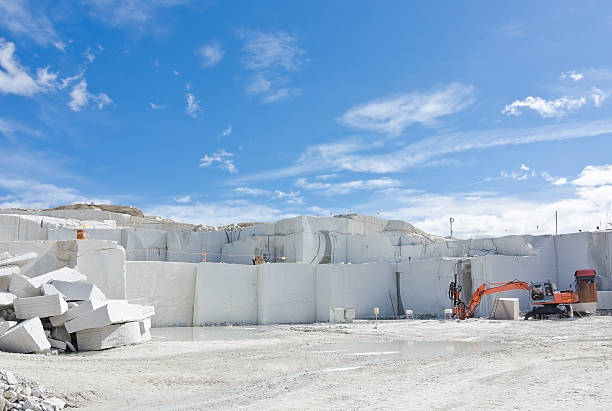Travelling With Granite Quarries in South Africa: A Visual Odyssey
Discovering the Rich History and Sustainable Practices of Granite Quarrying
As we stand on the precipice of discovering the elaborate tapestry of granite quarrying, a journey through time reveals not just the physical act of removing rock but also the social and historical relevance woven right into the extremely fabric of this technique. From the ancient beginnings that laid the structure for modern quarrying strategies to the lasting techniques that are shaping the future of this sector, each carve mark on granite surface areas informs a story waiting to be discovered (granite quarries in south africa). The legacy of granite quarrying stretches much beyond mere removal; it is a testament to human ingenuity, strength, and the long-lasting appeal of this marvelous stone
Ancient Origins of Granite Quarrying
Dating back to old civilizations, the method of quarrying granite has actually been an indispensable component of human background and building innovation. The earliest evidence of granite quarrying go back to old Egypt, where massive pyramids and complex sculptures were crafted from this long lasting stone. The Egyptians utilized primitive devices to extract granite blocks from quarries, showcasing the value of this product in their huge buildings.
Moving on in history, the Greeks likewise made substantial contributions to the quarrying of granite. The Greeks utilized granite in various building wonders, such as temples and statues, demonstrating their ability in shaping and sculpting this hardy rock. The Romans additionally improved the strategies of quarrying granite, utilizing innovative tools like blades and hammers to remove and form granite for their iconic structures.
Via the centuries, the technique of quarrying granite has actually advanced, with modern innovations improving efficiency while preserving the ageless allure of this natural stone - granite quarries in south africa. From ancient people to contemporary builders, the heritage of granite quarrying remains to shape our globe
Evolution of Quarrying Strategies
The development of quarrying methods has been marked by a constant development towards better effectiveness and precision in extracting granite. From the simple techniques employed by our forefathers to the innovative modern technologies utilized in contemporary quarrying procedures, the market has undergone substantial innovations. Early quarrying techniques included manual labor with basic tools such as knives, hammers, and wedges to remove granite blocks from the earth. As people advanced, strategies like fire-setting and primitive nitroglycerins were introduced to promote the removal process.
In even more recent times, the arrival of equipment transformed the quarrying market, making it possible for much faster extraction rates and raised productivity. Technologies such as diamond cable saws, high-pressure water jets, and pneumatically-driven drills have become basic in modern quarries, allowing for specific cutting and reduced waste. Moreover, advancements in computer-controlled devices and 3D modeling have actually optimized quarrying operations, leading to very little ecological influence and enhanced sustainability techniques. As the need for granite remains to climb, the development of quarrying strategies continues to be integral to conference sector needs efficiently and sustainably.
Social Value of Granite
Granite holds an extensive cultural value throughout various human beings due to its long-lasting presence in building work of arts and revered monoliths. The social value of granite expands beyond its physical characteristics; it symbolizes resilience, security, and eternity, making it an click reference icon of withstanding heritages and practices.

Sustainable Practices in Quarrying
In the middle of the rich background of granite quarrying and its cultural significance lies an expanding emphasis on lasting practices within the sector. As environmental awareness and concerns concerning source exhaustion have enhanced internationally, the quarrying sector has actually significantly embraced lasting techniques to minimize its influence on the environment and bordering communities.

Furthermore, reclamation and rehab of quarry websites post-extraction are indispensable to lasting techniques. By bring back quarried locations to a natural or beneficial state, such as producing wild animals habitats or entertainment rooms, quarriers can offset the environmental footprint of their operations and contribute favorably to the neighborhood ecological community.
Tradition of Granite Quarrying
With a historical backdrop soaked in workmanship and commercial development, what enduring impact has granite quarrying left on the landscape of contemporary culture? The tradition of granite quarrying transcends plain removal methods; it has actually formed architectural marvels, city landscapes, and social heritage worldwide. The resilient nature of granite has made it a favored selection for monuments, structures, and facilities, standing as Home Page a testament to the ability and artistry of quarry employees throughout generations.
Furthermore, the economic impact of granite quarrying can not be neglected. The industry continues to offer employment possibility and drive local economies in areas where granite extraction prevails. It has also stimulated technological developments in quarrying strategies and devices, causing more reliable and sustainable methods.
In terms of sustainability, the legacy of granite quarrying includes efforts to browse around these guys alleviate ecological effects with recovery jobs and responsible resource monitoring. By stabilizing economic rate of interests with ecological stewardship, the industry aims to make certain that future generations can remain to benefit from this enduring all-natural source.
Final Thought
